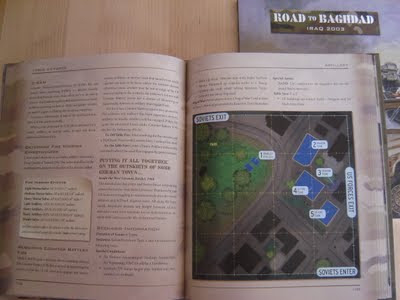Style
A few early typos aside, there’s really nothing I can complain about on the production side of things, and there’s plenty I am pleased with:
- Proper cloth binding (that’s hardback to you) which means this book will last and it will stay open on the table
- Well laid out, with plenty of whitespace (the margins and such which make a book like this readable) but not so much that makes you feel like you’ve been cheated. Also, the headings, sub-headings and text boxes make it easy to quickly scan a page
- A decent contents section and a good index are hugely important and often neglected – how often do wargamers spend five minutes looking for some rule they’re not sure about?
- The art is just fantastic. A healthy mix of drawn artwork (from other Osprey books), photographs (from the frontline) and gaming miniatures in action.
Substance
But who am I kidding; most of us do not buy wargaming rules just to look at the pretty pictures (even if that’s all we do with many of them!). One thing immediately stands out about the book:
- Not only do we get a general ‘big picture’ introduction from Shawn & Robbie Carpenter at the beginning; but littered throughout the book are individual designers’ notes relating to single aspects of the rules. I really appreciate the insight into a designer’s head, both at the high level and drilling down to an individual decision.
- The rules are clearly written, and we are in no doubt that a level of abstraction is intended. There is no discussion of the thickness of armour on a particular tank, nor the relative benefits of 5.56mm vs. 7.62mm ammunition.
- Linking to that aspect, the fact is that these rules are outcome-driven and not process-driven. The quality of the troops is crucial and the tactics utilised vital. The player doesn’t make decisions which his alter ego on the battlefield (typically the platoon commander) wouldn’t.
- The quality of troops is modelled by the use of different die-types. From D12 for very rare über-soldiers, to D6 for badly trained militia and such. Troops have a score on a similar scale for morale. Depending on the circumstances more dice may be thrown but typically the outcome is determined through opposing die rolls.
- Battlefield friction occurs primarily through Fog of War cards, which may be viewed as a random events deck. When things heat up, unexpected things happen.
- The rules are built up from the most basic principles into more complex facets (like vehicles, or asymmetric engagements) and each time an extra aspect is added there is a small scenario to demonstrate
- In an asymmetric engagement scenario balance comes from a different set of victory objectives, even though the forces involved may be wildly different in behaviour and quality
For those who have encountered the system before, is there any reason you should buy this book?
- Since first published in 2006, Ambush Alley has undergone some big changes. Extra rules have been added, the scale of the game has increased and the prospect of regular forces clashing has come into it. This edition represents the definitive clean-up of the sprawling game engine.
- As well as that, a lot of things have been tightened up. A lot of games have been run over the last five years, and a lot of questions have been asked on the forum and it’s obvious that things that were clear in the small group are less so when a rule set is published and set free!
- The vehicle rules are now more streamlined and easier to use. While tables aren’t for everyone, I can definitely say the new system works better.
- There’s a very nice unit-driven campaign system in the book (which you may recognise if you bought the Vietnam supplement ‘Ambush Valley’. In deciding to just follow the platoon involved (or in tracking an insurgency develop) it’s avoided most of the bugbears of campaign wargaming.



I've been really impressed with the book too. My only beef is that the Action/Reaction system should've been described before the combat system. It's...well, not complex, but it is different and they refer to it a lot before they try and explain what it is. Plus, I like my rules to be ordered as they are when you play. Since you have to activate/react before you move or shoot, I expect to see those rules earlier in the book.
ReplyDeleteStill, I got a chance to try a game at a convention a few weeks back and it completely sold me on the system so I'm anxious to give it a spin.
I was surprised by the order of the rules too, particularly since it used to be in the order you described !
ReplyDeleteI guess for some reason people thought it was better to change the order...
still , great book,... cool AAR
Francisco
Note: when I say used to be, I mean on the previous version of the book, the one not done with Osprey
ReplyDeleteFrancisco
It's a fine book - I look forward to the Cold War supplement.
ReplyDelete@ Blue Gargantua and Francisco
ReplyDeleteI think during the last edition, people had mentioned they wanted to know what they could do (i.e. moving and shooting) before they wanted to know when they could do it (i.e. reactions).
It's probably a difficult choice to make, I can see the logic for doing it one way or the other
@ Ashley
Thanks! I shall have to take a look at doing mine later